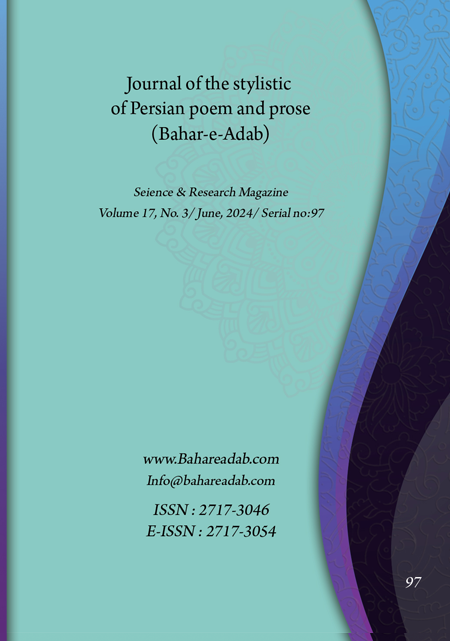- Count View : 400
- آدرس کوتاه شده مقاله: https://bahareadab.com/article_id/1620
- کد doi مقاله: Doi: 10.22034/bahareadab.2024 .17 .7378
Journal of the stylistic of Persian poem and prose
volume Number 17،
number In Volume 3،
،
issue Number 97
Stylistic Analysis of Aref Chahabi’s Lyric Poetry
Sharafatullah Haqjoo , Esmaeil Tajbakhsh (Author in Charge)
Abstract
BACKGROUND AND OBJECTIVES: Mullah Abdullah Aref Chahabi is a contemporary Persian poets from Tkhar province of Afghanistan. Though researches have been done in the realm of introduction to his poetical themes and thoughts, but his poetry have not been studied from a stylistic perspective. The main objective of this research is to analyze the stylistic features of his lyric poetry, exploring them in five linguistic, rhetorical, and ideological layers, so that a bright image of his verbal art can be drawn to readers.
METHODOLOGY: The present research is a theoretical study that was carried out using the literature review method and analytical-descriptive approach. The scope and community of study was Aref Chahabi’s poetical work which was published by Saadat Publications.
FINDINGS: Aref has used artistic phonological structures to create musical proportion relevant to poetic themes and made concerted context and space to discourse content from recurrence of vowels and consonants, as he has applied language lexicon specially widespread frequency of identical and objective words effectively associable with meanings and senses and has drew colorful paintings of events and scenes. In Aref’s poems, phrases, clauses and sentences are used in appropriate norms of formal language and its poetic applications to explain thought and ideology. He has utilized figures of speech and rhetoric metaphors to create imaginary poetic pictures, make attractive features and draw dramatic scenes for discourse.
CONCLUSION: The stylistic study of Aref’s lyric poetry reveals that the poet has functioned skillfully in linguistic (phonetic, lexical and syntactic), rhetorical, and ideological layers. Most of his lyric poems are composed in the Hazaj and Ramal meters, often being compound verses. The poet"s emphasis on verbal devices such as repetition and refrain is substantial. Esthetic and colloquial lexicon has higher frequency in his poetry. Use of simple sentences and declarative mode, proceeding verb from other parts of the sentence are syntactic characteristics of his lyric poems. In rhetorical layer, artistic phrases and constructions are full of similes, metaphors, allusions and ironies that have increased attraction of his poetical images. The most basic themes that have reflected in his poetry are love, description of nature and social life.
Keyword
Stylistic
, stylistics
, sonnets
, Language
, rhetorical layout
, ideological layer
- Ahmadi, H, Panahi, M and Yeganeh, S. (2019). Layered stylistics of Salman Savji's lyrics (syntactic and lexical layers). Scientific Quarterly of Applied Rhetoric and Rhetorical Criticism 5 issue, P 18.
- Khaghani Isfahani, M and Gurban khani, M. (2014). Metaphor from the perspective of Arabic rhetoric and cognitive linguistics. Scientific-research magazine. Iranian Association of Arabic Language and Literature, Vol. 35, Summer 2014, pp. 104.
- Raskhmohand, M. (2014). An introduction to cognitive linguistics. Tehran: Side, P 76.
- Rostgarfasai, M. (2010). Types of Persian poetry. Shiraz: Navid Shiraz Publications, 337.
- Rezaei, J .(2005). The role of analogy in stylistic transformations. Persian language and literature biannual research, volume 5, autumn and winter, pp 85-100.
- Shafiei Kadkani, M. (2018). Poetry music. 19th edition Tehran: Age Publishing, pp. 28, 91.
- Shafiei Kadkani, M. (2011). Resurrection of words (3rd edition). Tehran: Sokhon Publications, 439.
- Shamisa, S. (2018). A fresh look at the original. second edition. Tehran: Mitra Publishing House, pp. 73-74.
- Shamisa, S. (2017). Familiarity with prosody and rhyme. Tehran: Mitra Publishing, pp. 24, 101.
- Shamisa, S. (2011). Generalities of stylistics. Tehran: Ferdous, P 151.
- Shamisa, S. (2006). A new and innovative look. Third edition, Tehran: Mitra, P 34.
- Safavi, K. (2012). An introduction to semantics, fifth edition. Tehran: Surah Mehr, P 266.
- Aref, A. (2014). Diwan Aref Chahabi; by the efforts of Mohammad Ebrahim Chahabi; Kabul: Saadat.
- Alvi Moghadam, M and Ashraf Zadeh, R. (2007). Meanings and expressions (8th edition). Tehran: Samit Publications.
- Fatuhi, M. (2011). Stylology, theories, approaches and methods, Tehran: Sokhn, P 34- 300.
- Kezazi, M. (1989). Aesthetics of Persian speech (expression). Tehran: Nashr al-Karzan, p. 140.
- Mohammadnejad alizamini, Y and Leila E. (2017). Analysis of the stylistic functions of simile in the first volume of Ferdowsi's Shahnameh. Literary Text Research, Year 24, No. 84, pp. 121-152.
- Mohammad Tousi, N. )2013(. Criterion of poems. Correction: Ali Asghar Ghahrani Maqbal. Tehran: Academic Publishing Center, P 114.
- Mehri, F. (2018). Layered stylistics of Iran's contemporary social lyric, doctoral thesis. Hakim Sabzevari University, P 36.
- Mirsadeghi, J and Mirsadeghi Zolqader, M. (1998). Dictionary of the art of story writing. Tehran: Mahnaz Kitab, P 77.
- Mirsadeghi Zulqadr, M. (Zulqadr). (1997). Dictionary of poetic art. Tehran: Mahnaz Kitab, P 66.
- Nikobakht, N. (2014). Investigating the musical role of rhyme in Mohammad Ali Bahmani's Ghazal. Dor Dari Scientific-Specialist Quarterly, No. 16. pp. 49-60.
- Yamin, M. (2013) Lexicography in Pasi-Dari language, Kabul: Saeed, P 1.
- Yule, G. (2011). Language usage. Translated by Mohammad Amozadeh and Manouchehr Tawanger. Tehran: semat, P 12.

